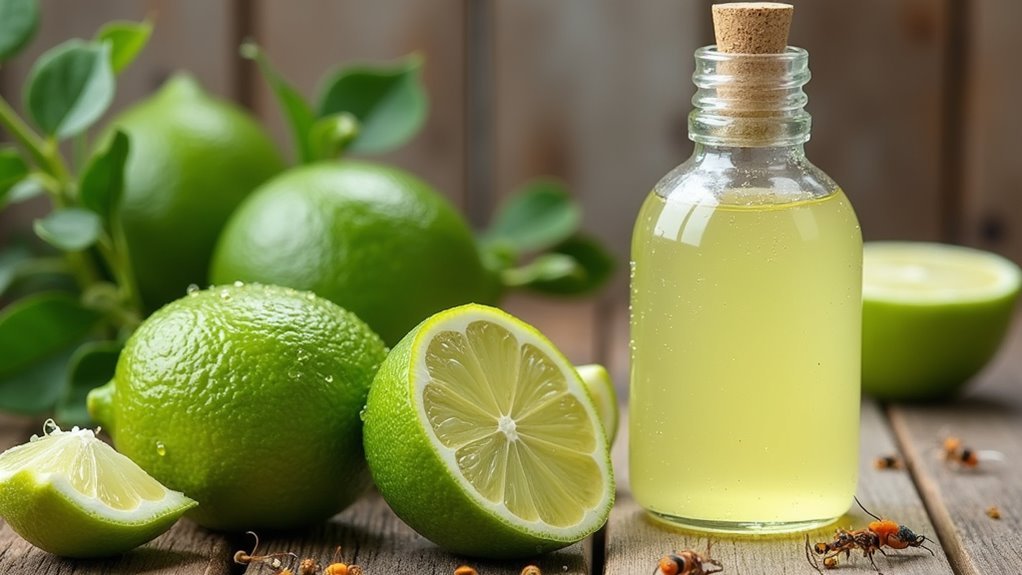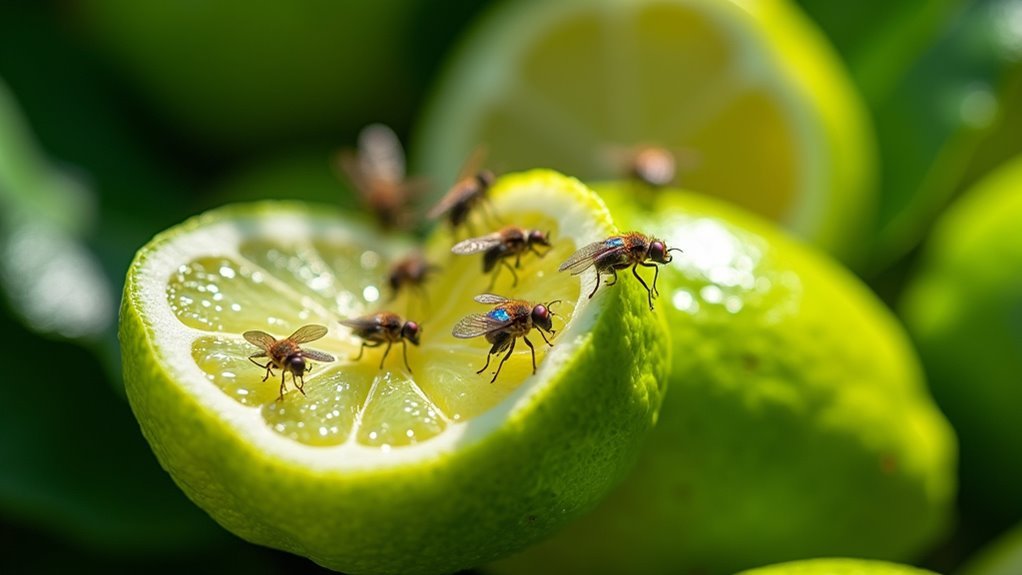You’re experiencing nature’s own pest control system when lime peels release limonene, a powerful monoterpene that disrupts insect navigation and masks the food aromas that attract unwanted pests to your home and garden. This natural compound comprises over 90% of citrus essential oils and effectively deters mosquitoes, flies, ants, and cockroaches by interfering with their behavior patterns. Lime peels contain higher oil concentrations than other citrus fruits, making them particularly potent against various insects. Understanding proper preparation methods will maximize their pest-fighting potential.
The Science Behind Lime Peel Insect Repellent Properties

When you squeeze a fresh lime peel, you’re releasing limonene, a powerful natural compound that acts as an effective insect repellent against mosquitoes, cockroaches, and other common pests.
This essential oil contains concentrated insecticidal properties that make lime peels highly effective for natural pest control. The volatile organic compounds within these peels create a strong citrus scent that disrupts insect behavior by masking food aromas and interfering with their scent trails.
Research published in Bioresource Technology confirms lime peel extracts work as a sustainable pest deterrent.
You’ll find lime peels contain higher oil concentrations than orange peels, making them more potent when used fresh or as concentrated extracts for repelling unwanted insects naturally.
Limonene: The Active Compound That Deters Pests
You’ve probably smelled that sharp, citrusy scent when you peel a lime – that’s limonene, the powerful compound responsible for repelling insects.
This natural chemical doesn’t just smell good to you; it actively disrupts pests’ ability to navigate and find food by masking their scent trails.
Understanding limonene’s concentration levels and how it works will help you maximize your lime peels’ pest-fighting potential.
What Is Limonene?
The secret behind lime peels’ pest-deterring power lies in limonene, a naturally occurring chemical compound that gives citrus fruits their distinctive, sharp aroma. This monoterpene comprises over 90% of citrus essential oils, making it exceptionally potent for natural pest control.
When you use lime peels as an insect repellent, you’re harnessing limonene’s ability to disrupt insects’ scent-tracking mechanisms.
Limonene works by masking food aromas that typically attract pests and interfering with their navigation systems. Research shows it effectively repels mosquitoes, flies, and ants by creating an unwelcoming environment.
However, you’ll find that concentrated citrus oil products containing higher limonene levels work more effectively than fresh peels, which contain lower concentrations of this powerful compound.
How Limonene Works
Understanding limonene’s pest-deterring mechanisms requires examining how this potent compound interacts with insects’ biological systems. This natural insecticide disrupts pest behavior through its powerful citrus aroma, which interferes with their sensory receptors and navigation abilities.
Here’s how limonene functions as an effective pest deterrent:
- Sensory Disruption – The strong citrus aroma overwhelms insects’ sensory receptors, making it difficult for them to locate food sources or communicate through scent trails.
- Biological Interference – Limonene’s chemical structure actively disrupts insects’ nervous systems, causing disorientation and deterring them from treated areas.
- Enhanced Potency – When limonene’s extracted in concentrated forms, it becomes considerably more effective than traditional chemical insecticides, offering superior insect-repelling properties while remaining environmentally safe.
Concentration Levels Matter
Two factors determine limonene’s effectiveness as a natural pest deterrent: concentration levels and application freshness. You’ll find that essential oils pack considerably more punch than citrus peels alone. While lime peels contain less than 1.2% limonene, essential oils boast concentrations exceeding 90%, making them far superior insect repellent options.
| Source | Limonene Concentration |
|---|---|
| Fresh Lime Peels | <1.2% |
| Essential Oils | >90% |
| Orange Peels | <1.2% |
| Commercial Sprays | 5-15% |
Higher concentration levels directly correlate with stronger aromatic properties that effectively disrupt scent trails and mask food aromas attracting pests. However, evaporation remains your biggest challenge. Fresh applications maintain ideal pest deterrent effectiveness, as limonene rapidly dissipates from exposed peels.
Which Insects Are Most Affected by Lime Peels
When you’re dealing with household pests, lime peels prove most effective against specific insect types that rely heavily on scent for orientation and survival.
The limonene compound in lime peels creates a powerful citrus scent that disrupts these insects’ natural behaviors.
The concentrated limonene in citrus peels acts as a natural chemical deterrent that interferes with pest navigation and feeding patterns.
You’ll find lime peels particularly effective against these three pest categories:
- Mosquitoes and flies – These flying insects are strongly repelled by the potent citrus scent, making lime peels an excellent natural pest control method for outdoor areas.
- Ants – Lime peels disrupt their scent trails, preventing them from locating food sources and orienting effectively through your home.
- Cockroaches – Research shows concentrated lime peel extracts considerably reduce cockroach presence, as they avoid areas treated with limonene.
These insects’ sensitivity to citrus compounds makes repelling them with lime peels surprisingly effective.
Comparing Lime Peels to Other Citrus Fruits for Pest Control

While lime peels excel at repelling these common household pests, they’re not the only citrus option available for natural pest control.
However, lime peels clearly outperform orange peels as an insect repellent. The essential oils in lime peels contain over 90% limonene, while orange peels contain less than 1.2%. This massive difference translates to superior repellent effects against mosquitoes and cockroaches.
You’ll find lime peels work immediately in their fresh state, unlike orange peels that require composting for maximum effectiveness.
Studies consistently show lime peel extracts demonstrate stronger pest control capabilities across various insects.
When you’re choosing between citrus options, lime peels offer the most potent natural solution for keeping unwanted pests away from your home.
How to Prepare Fresh Lime Peels for Maximum Effectiveness
Before you can harness lime peels’ powerful insect-repelling properties, you’ll need to prepare them correctly to maximize their effectiveness. Proper preparation guarantees the essential oils that repel insects are released at their strongest concentration.
Follow these essential steps for ideal results:
- Wash and cut into small pieces – Thoroughly clean limes to remove pesticides, then cut peels into small fragments or grind into coarse powder to increase surface area and release more oils.
- Position for maximum exposure to air – Place prepared lime peels in sunny outdoor areas or near entry points where airflow enhances volatile compound release.
- Regularly replace and store unused peels – Replace peels every few days to maintain potency, and store unused portions in cool, dry places to preserve freshness.
Making Homemade Lime Peel Spray Step-by-Step

You’ll need just a few simple items to create an effective lime peel spray that keeps insects at bay.
The preparation process involves extracting essential oils from fresh peels through a gentle simmering method.
Once you’ve prepared your spray, proper application techniques will maximize its pest-repelling power in your garden or home.
Gathering Required Ingredients
Since fresh lime peels contain limonene—a powerful natural compound that effectively repels various insects—you’ll want to start by collecting peels from recently used limes rather than dried or aged ones.
To create an effective concentrated solution, you’ll need these essential ingredients:
- Fresh lime peels – About 1 cup of peels from recently juiced limes for maximum limonene content
- Water – 4 cups of clean water to create the proper dilution ratio
- Spray bottle – For easy application when you’re ready to apply the mixture to outdoor areas
The key to extracting powerful essential oils lies in using peels that haven’t lost their potency.
Once you’ve gathered these simple ingredients, you’ll be ready to simmer the mixture and create your own pest-repelling spray that’s both natural and highly effective against unwanted insects.
Preparation and Application
Now that you have your ingredients ready, making the lime peel spray requires just a few straightforward steps.
Begin preparation by chopping your lime peels into small pieces to maximize essential oils extraction. Boil the chopped peels in water for 10-15 minutes, allowing the natural insect repellent compounds to infuse thoroughly.
Once cooled, strain out solid pieces and transfer the liquid into your spray bottle.
For proper application, spray directly onto plants and surrounding areas where insects gather. The natural compounds work best when applied consistently, so reapply every few days or after rainfall.
This regular application schedule maintains the spray’s effectiveness against unwanted pests. The concentrated essential oils from the lime peels create a protective barrier that deters insects naturally without harsh chemicals.
Proper Storage and Shelf Life of Lime Peel Solutions
Maintaining the potency of your lime peels solutions requires careful attention to storage conditions and timing.
You’ll want to store these natural repellents in a cool dark place to prevent degradation of essential oils that provide their insect-repelling properties.
Here are three essential storage methods to maximize effectiveness:
- Refrigerate in airtight containers – Your lime peel solutions stay potent for up to two weeks when properly sealed.
- Dry peels before storage – Remove moisture to prevent mold growth and extend shelf life considerably.
- Freeze for long-term use – Freezing preserves lime peels for several months while maintaining their repelling power.
Always label your storage containers with preparation dates.
This simple practice helps you track freshness and guarantees you’re using solutions at peak effectiveness against insects.
Application Methods for Indoor Pest Control
Once you’ve properly stored your lime peel solutions, you’re ready to deploy them strategically throughout your home for maximum pest control impact.
For effective indoor pest control, chop lime peels into small pieces and scatter them around kitchens and entryways where insects commonly appear. You can also place peels in cloth sachets and hang them in cabinets or closets, allowing natural oils to release gradually and deter insects without mess.
These application methods work best when you replace fresh peels every few days, maintaining their potency as essential oils evaporate quickly.
Replace lime peels every few days to maintain their pest-deterrent potency as essential oils evaporate rapidly.
Enhance your pest deterrent by combining lime peels with vinegar or essential oils. Always monitor pest activity in treated areas to assess effectiveness and adjust placement frequency for peak results.
Using Lime Peels Around Gardens and Outdoor Spaces
While indoor applications prove effective, extending your lime peel pest control strategy to gardens and outdoor spaces offers even greater potential due to the peels’ higher limonene concentrations compared to other citrus fruits.
The volatile oils release a strong citrus scent that’ll deter pests like mosquitoes, flies, and ants from your outdoor spaces.
To maximize this natural insect repellent’s effectiveness:
- Chop or grind fresh lime peels and scatter them around plants or seating areas to create protective barriers.
- Replace peels regularly since oils evaporate quickly and lose their pest deterrent properties.
- Focus on high-traffic areas where you need the strongest protection from unwanted insects.
Using lime peels promotes sustainable gardening by reducing chemical pesticide reliance while recycling organic waste into an effective pest control solution.
Limitations of Lime Peels as Pest Deterrents
Despite lime peels’ potential as a natural pest deterrent, several notable limitations reduce their practical effectiveness compared to commercial alternatives.
You’ll find that lime peels contain only low concentration levels of limonene, making them considerably weaker than concentrated essential oils. The volatile oils that provide repellent properties evaporate quickly once peels dry out, severely limiting their duration of effectiveness.
Limited scientific evidence supports claims about lime peels’ pest-fighting abilities, with most assertions lacking rigorous testing.
Additionally, these peels decompose slowly due to their waxy coating, reducing long-term garden benefits.
Perhaps most problematically, lime peels may actually attract unwanted pests like rodents rather than repelling insects, making them an ineffective pest deterrent for reliable outdoor protection.
Safety Considerations When Using Citrus-Based Repellents
Although lime peels present effectiveness challenges, you’ll want to understand proper safety protocols before using any citrus-based repellents around your home or garden.
Despite their non-toxic properties, citrus oils require careful handling to prevent skin irritation and allergic reactions.
Essential Safety Considerations:
- Conduct patch tests – Apply small amounts of lime peel extracts on your skin first to check for sensitivity before widespread use.
- Ensure proper ventilation – Keep indoor areas well-ventilated when using citrus-based repellents to prevent respiratory discomfort from overwhelming scents.
- Follow manufacturer guidelines – When using commercial citrus oil products, strictly adhere to recommended dilution ratios and application methods.
These safety considerations help you maximize benefits while minimizing risks associated with concentrated citrus compounds.
Cost Analysis: Lime Peels Vs Commercial Insect Sprays
Three key factors determine whether lime peels offer genuine cost savings compared to commercial insect sprays: initial expense, application frequency, and long-term effectiveness.
You’ll find lime peels cost virtually nothing when sourced from home citrus consumption, while commercial insect sprays range from $5 to $30 per bottle. This cost analysis reveals lime peels as an exceptional natural alternative through recycling organic materials that would otherwise become waste.
However, you must consider pest pressure levels in your area. Commercial sprays contain concentrated formulas requiring less frequent application, whereas lime peels need regular replacement to maintain their essential oils’ potency.
Despite this, you’re still gaining environmental impact benefits while avoiding synthetic chemicals, making lime peels economically and ecologically superior for most household pest control situations.
Combining Lime Peels With Other Natural Pest Control Methods
You can amplify lime peels’ pest-repelling power by combining them with essential oils like lemon or orange, which contain higher concentrations of limonene and other active compounds.
Creating an integrated garden strategy means pairing lime peels with physical barriers such as fine mesh netting and other natural repellents like vinegar or garlic for all-encompassing protection.
This multi-layered approach not only targets different pest species but also attracts beneficial insects that naturally control harmful populations in your garden.
Essential Oil Combinations
When you combine lime peels with other natural pest control methods, you’ll create powerful synergistic effects that target a broader range of insects than using lime alone.
Essential oils extracted from lime peels contain concentrated limonene that you can mix with carrier oils for enhanced repellent properties. These combinations work by disrupting insect pheromone trails, making it harder for pests to navigate and locate food sources.
Here are three effective essential oil combinations for superior pest control:
- Lime peel oil + peppermint oil – Creates a potent dual-action repellent
- Lime extract + diatomaceous earth – Provides abrasive and chemical deterrent properties
- Lime peel mixture + vinegar spray – Forms a protective barrier on plant surfaces
Regular reapplication maintains effectiveness while delivering fresh, natural deterrent scents.
Integrated Garden Strategies
Although lime peels offer significant pest control benefits on their own, integrating them into an extensive garden management system amplifies their effectiveness exponentially.
You can enhance your natural insect repellent approach by combining lime peels with crop rotation practices, disrupting pest life cycles while maintaining chemical-free protection. These integrated garden strategies work best when you layer multiple defenses together.
Mixing lime peels with other natural repellents like neem oil creates powerful barriers using different mechanisms.
When you add lime peels to your compost, you’re enriching soil nutrients while providing slow-release pest deterrent effects throughout your garden.
Covering vulnerable plants with fine mesh alongside lime peel applications creates thorough protection.
This holistic pest management strategy guarantees you’re addressing insects from multiple angles, maximizing your garden’s natural defense system.
When to Choose Professional Pest Control Over DIY Solutions
While lime peels offer an effective, natural approach to pest management, certain situations demand the expertise and advanced tools that only professional pest control services can provide.
You should consider professional pest control over DIY solutions when:
- Health risks emerge – Disease-carrying mosquitoes or rodents require immediate professional intervention to protect your family’s safety, as organic insecticides may prove insufficient.
- Persistent pest issues continue – When lime peels and other home remedies fail repeatedly, consulting a professional becomes essential for targeted treatment strategies.
- Structural damage threatens your property – Termites or carpenter ants demand specialized pest management strategies that exceed typical DIY solutions’ capabilities.
Professional services possess advanced equipment and knowledge to address complex infestations effectively, preventing costly repairs and ensuring thorough protection.
Frequently Asked Questions
What Bugs Does Lime Keep Away?
You’ll find lime effectively repels mosquitoes, cockroaches, and ants due to its limonene content. The strong citrus scent disrupts insects’ scent trails, making it useful against various household pests and garden insects naturally.
Does Lemon Peel Repel Insects?
You can use lemon peels to repel insects because they contain limonene and essential oils that deter mosquitoes, ants, and other pests by disrupting their scent trails naturally.
Why Should You Place Orange Peels Around Your Patio?
You should place orange peels around your patio because they’ll repel mosquitoes and flies naturally. The limonene in fresh peels masks food aromas that attract insects, creating an eco-friendly barrier without harmful chemicals.
Are Lime Peels Good for the Garden?
You shouldn’t place lime peels directly in your garden since they decompose slowly and attract pests. Instead, you’ll get better results by composting them first to create nutrient-rich soil amendments.
In Summary
You’ve discovered that lime peels offer a natural, cost-effective alternative to chemical repellents through their limonene content. While they’re particularly effective against ants, mosquitoes, and flies, you shouldn’t expect them to solve severe infestations. You’ll get best results by combining fresh peels with other natural methods and replacing them regularly. Remember, if you’re dealing with persistent pest problems, don’t hesitate to consult professional exterminators for thorough solutions.





Leave a Reply